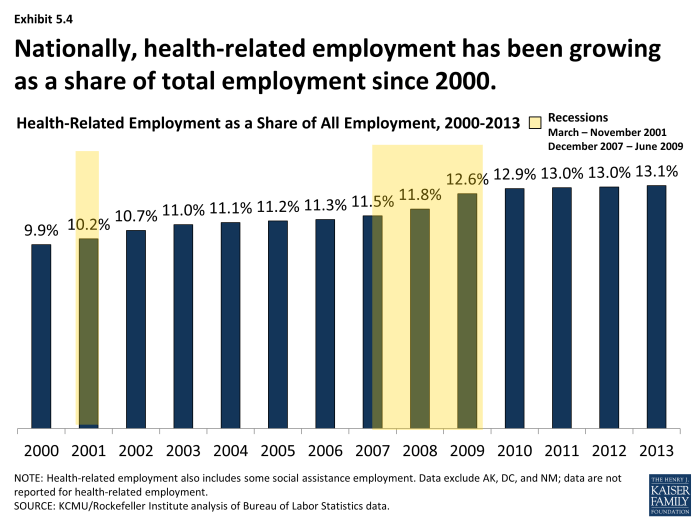Economic and Fiscal Trends in Expansion and Non-Expansion States: What We Know Leading Up to 2014
How Do Expansion And Non-Expansion States Compare? - Employment
Also part of discussions in states over the adoption of the Medicaid expansion has been the effect on employment. State debates have also examined the potential employment gains from the new expansion spending and increased economic activity; early evidence from some expansion states like Kentucky have noted increased employment since adopting the Medicaid Expansion.
Unemployment
- After peaking in 2010 at the height of the economic downturn, the national unemployment rate in 2013 had fallen to 7.4 percent.
- During the Great Recession, both expansion and non-expansion states saw notable increases in the unemployment rate. Unemployment rates have continued to fall for the typical state in both groups since peaking in 2009 or 2010. (Exhibit 5.1)
- There is a notable amount of variation within both groups in terms of the unemployment rate. Expansion states in 2013 had employment rates ranging from 9.5% in Nevada down to 2.9% in North Dakota; Non-expansion states had unemployment rates ranging from 8.7% in Mississippi to 3.8% in South Dakota. (Exhibit 5.2)
Total Employment
- The total number of jobs fell significantly during the economic downturn; while employment had increased in the years leading up to the major ACA coverage expansions, total nonfarm employment had yet to return to pre-Recession levels.
Health-Related Employment
- As total employment levels declined in response to the Great Recession, employment in health and related fields remained strong. (Exhibit 5.3)
- As a result, health-related employment has increased as a share of total employment over time, particularly since the Great Recession. (Exhibit 5.4)
- Health-related employment in the typical expansion state has historically been higher than in the typical non-expansion state. (Exhibit 5.5)
- All states saw strong growth in health-related employment from 2000 through 2013; however growth in this sector slowed for both groups in 2008-2013 compared to the earlier period (2000 to 2007). (Exhibit 5.6)
How Do Expansion And Non-Expansion States Compare? - State Budgets
Appendix A - Methodology and Definitions
x
Exhibit 5.1
x
Exhibit 5.2
x
Exhibit 5.3
x
Exhibit 5.4
x
Exhibit 5.5
x








